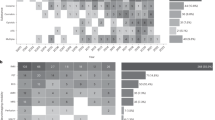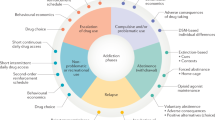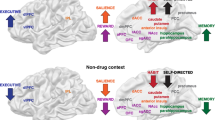Abstract
Drugs of abuse have very different acute mechanisms of action but converge on the brain's reward pathways by producing a series of common functional effects after both acute and chronic administration. Some similar actions occur for natural rewards as well. Researchers are making progress in understanding the molecular and cellular basis of these common effects. A major goal for future research is to determine whether such common underpinnings of addiction can be exploited for the development of more effective treatments for a wide range of addictive disorders.
This is a preview of subscription content, access via your institution
Access options
Subscribe to this journal
Receive 12 print issues and online access
$209.00 per year
only $17.42 per issue
Buy this article
- Purchase on SpringerLink
- Instant access to full article PDF
Prices may be subject to local taxes which are calculated during checkout


Ann Thomson
Similar content being viewed by others
References
Koob, G.F. & Le Moal, M. Drug addiction, dysregulation of reward, and allostasis. Neuropsychopharmacology 24, 97–129 (2001).
Nestler, E.J. Molecular basis of long-term plasticity underlying addiction. Nat. Rev. Neurosci. 2, 119–128 (2001).
Di Chiara, G. et al. Dopamine and drug addiction: the nucleus accumbens shell connection. Neuropharmacology 47 (suppl.) 227–241 (2004).
Volkow, N.D., Fowler, J.S., Wang, G.J. & Swanson, J.M. Dopamine in drug abuse and addiction: results from imaging studies and treatment implications. Mol. Psychiatry 9, 557–569 (2004).
Wise, R.A. Dopamine, learning and motivation. Nat. Rev. Neurosci. 5, 483–494 (2004).
Boehm, S.L., II et al. gamma-Aminobutyric acid A receptor subunit mutant mice: new perspectives on alcohol actions. Biochem. Pharmacol. 68, 1581–1602 (2004).
Dani, J.A., Ji, D. & Zhou, F.M. Synaptic plasticity and nicotine addiction. Neuron 31, 349–352 (2001).
Howlett, A.C. et al. Cannabinoid physiology and pharmacology: 30 years of progress. Neuropharmacology 47 (suppl.) 345–358 (2004).
Everitt, B.J. & Wolf, M.E. Psychomotor stimulant addiction: a neural systems perspective. J. Neurosci. 22, 3312–3320 (2002).
Robinson, T.E. & Berridge, K.C. Addiction. Annu. Rev. Psychol. 54, 25–53 (2003).
Hyman, S.E. & Malenka, R.C. Addiction and the brain: the neurobiology of compulsion and its persistence. Nat. Rev. Neurosci. 2, 695–703 (2001).
Everitt, B.J., Cardinal, R.N., Parkinson, J.A. & Robbins, T.W. Appetitive behavior: impact of amygdala-dependent mechanisms of emotional learning. Ann. NY Acad. Sci. 985, 233–250 (2003).
Kalivas, P.W. Glutamate systems in cocaine addiction. Curr. Opin. Pharmacol. 4, 23–29 (2004).
Kelley, A.E. & Berridge, K.C. The neuroscience of natural rewards: relevance to addictive drugs. J. Neurosci. 22, 3306–3311 (2002).
Tobler, P.N., Fiorillo, C.D. & Schultz, W. Adaptive coding of reward value by dopamine neurons. Science 307, 1642–1645 (2005).
Avena, N.M. & Hoebel, B.G. A diet promoting sugar dependency causes behavioral cross-sensitization to a low dose of amphetamine. Neuroscience 122, 17–20 (2003).
Heinrichs, S.C. & Koob, G.F. Corticotropin-releasing factor in brain: a role in activation, arousal and affect regulation. J. Pharmacol. Exp. Ther. 311, 427–440 (2004).
Kalivas, P.W., Volkow, N. & Seamans, J. Unmanageable motivation in addiction: a pathology in prefrontal-accumbens glutamate transmission. Neuron 45, 647–650 (2005).
Saal, D., Dong, Y., Bonci, A. & Malenka, R.C. Drugs of abuse and stress trigger a common synaptic adaptation in dopamine neurons. Neuron 37, 577–582 (2003).
Borgland, S.L., Malenka, R.C. & Bonci, A. Acute and chronic cocaine-induced potentiation of synaptic strength in the ventral tegmental area: electrophysiological and behavioral correlates in individual rats. J. Neurosci. 24, 7482–7490 (2004).
Thomas, M.J. & Malenka, R.C. Synaptic plasticity in the mesolimbic dopamine system. Phil. Trans. R. Soc. Lond. B Biol. Sci. 358, 815–819 (2003).
Kauer, J.A. Learning mechanisms in addiction: synaptic plasticity in the ventral tegmental area as a result of exposure to drugs of abuse. Annu. Rev. Physiol. 66, 447–475 (2004).
Carlezon, W.A., Jr. & Nestler, E.J. Elevated levels of GluR1 in the midbrain: a trigger for sensitization to drugs of abuse? Trends Neurosci. 25, 610–615 (2002).
Bonci, A. & Williams, J.T. Increased probability of GABA release during withdrawal from morphine. J. Neurosci. 17, 796–803 (1997).
Nestler, E.J. Molecular mechanisms of drug addiction. J. Neurosci. 12, 2439–2450 (1992).
Lu, L., Grimm, J.W., Shaham, Y. & Hope, B.T. Molecular neuroadaptations in the accumbens and ventral tegmental area during the first 90 days of forced abstinence from cocaine self-administration in rats. J. Neurochem. 85, 1604–1613 (2003).
Olson, V.G. et al. Regulation of drug reward by CREB: Evidence for two functionally distinct subregions of the ventral tegmental area. J. Neurosci. 25, 5553–5562 (2005).
Walters, C.L., Godfrey, M., Li, X. & Blendy, J.A. Alterations in morphine-induced reward, locomotor activity, and thermoregulation in CREB-deficient mice. Brain Res. 1032, 193–199 (2005).
Walters, C.L., Cleck, J.N., Kuo, Y.C. & Blendy, J.A. mu-Opioid receptor and CREB activation are required for nicotine reward. Neuron 46, 933–943 (2005).
Bolanos, C.A. & Nestler, E.J. Neurotrophic mechanisms in drug addiction. Neuromol. Med. 5, 69–83 (2004).
Pierce, R.C. & Bari, A.A. The role of neurotrophic factors in psychostimulant-induced behavioral and neuronal plasticity. Rev. Neurosci. 12, 95–110 (2001).
Lu, L. et al. A single infusion of brain-derived neurotrophic factor into the ventral tegmental area induces long-lasting potentiation of cocaine seeking after withdrawal. J. Neurosci. 24, 1604–1611 (2004).
Hall, F.S., Drgonova, J., Goeb, M. & Uhl, G.R. Reduced behavioral effects of cocaine in heterozygous brain-derived neurotrophic factor (BDNF) knockout mice. Neuropsychopharmacology 28, 1485–1490 (2003).
Nestler, E.J., Barrot, M. & Self, D.W. ΔFosB: A molecular switch for addiction. Proc. Natl. Acad. Sci. USA 98, 11042–11046 (2001).
McClung, C.A. et al. ΔFosB: A molecular switch for long-term adaptation. Mol. Brain Res. 132, 146–154 (2004).
McClung, C.A. & Nestler, E.J. Regulation of gene expression and cocaine reward by CREB and ΔFosB. Nat. Neurosci. 6, 1208–1215 (2003).
Shaw-Lutchman, T.Z. et al. Regional and cellular mapping of CRE-mediated transcription during naltrexone-precipitated morphine withdrawal. J. Neurosci. 22, 3663–3672 (2002).
Shaw-Lutchman, T.Z., Impey, S., Storm, D. & Nestler, E.J. Regulation of CRE-mediated transcription in mouse brain by amphetamine. Synapse 48, 10–17 (2003).
Barrot, M. et al. CREB activity in the nucleus accumbens shell controls gating of behavioral responses to emotional stimuli. Proc. Natl. Acad. Sci. USA 99, 11435–11440 (2002).
Brunzell, D.H., Russell, D.S. & Picciotto, M.R. In vivo nicotine treatment regulates mesocorticolimbic CREB and ERK signaling in C57Bl/6J mice. J. Neurochem. 84, 1431–1441 (2003).
Pandey, S.C., Roy, A., Zhang, H. & Xu, T. Partial deletion of the cAMP response element-binding protein gene promotes alcohol-drinking behaviors. J. Neurosci. 24, 5022–5030 (2004).
Constantinescu, A., Wu, M., Asher, O. & Diamond, I. CAMP-dependent protein kinase type I regulates ethanol-induced cAMP response element-mediated gene expression via activation of CREB-binding protein and inhibition of MAPK. J. Biol. Chem. 279, 43321–43329 (2004).
Walters, C.L. & Blendy, J.A. Different requirements for cAMP response element binding protein in positive and negative reinforcing properties of drugs of abuse. J. Neurosci. 21, 9438–9444 (2001).
Carlezon, W.A., Jr., Duman, R.S. & Nestler, E.J. The many faces of CREB. Trends Neurosci. 28, 436–445 (2005).
Self, D.W. et al. Involvement of cAMP-dependent protein kinase in the nucleus accumbens in cocaine self-administration and relapse of cocaine-seeking behavior. J. Neurosci. 18, 1848–1859 (1998).
Kreek, M.J. Drug addictions. Molecular and cellular endpoints. Ann. NY Acad. Sci. 937, 27–49 (2001).
Yao, W.D. et al. Identification of PSD-95 as a regulator of dopamine-mediated synaptic and behavioral plasticity. Neuron 41, 625–638 (2004).
Eisch, A.J. Adult neurogenesis: implications for psychiatry. Prog. Brain Res. 138, 315–342 (2002).
Robinson, T.E. & Kolb, B. Structural plasticity associated with exposure to drugs of abuse. Neuropharmacology 47 (suppl.) 33–46 (2004).
Littleton, J. & Zieglgansberger, W. Pharmacological mechanisms of naltrexone and acamprosate in the prevention of relapse in alcohol dependence. Am. J. Addict. 12 (suppl.) S3–S11 (2003).
Acknowledgements
Preparation of this review was supported by the National Institute on Drug Abuse.
Author information
Authors and Affiliations
Ethics declarations
Competing interests
The author declares no competing financial interests.
Rights and permissions
About this article
Cite this article
Nestler, E. Is there a common molecular pathway for addiction?. Nat Neurosci 8, 1445–1449 (2005). https://doi.org/10.1038/nn1578
Published:
Issue Date:
DOI: https://doi.org/10.1038/nn1578



